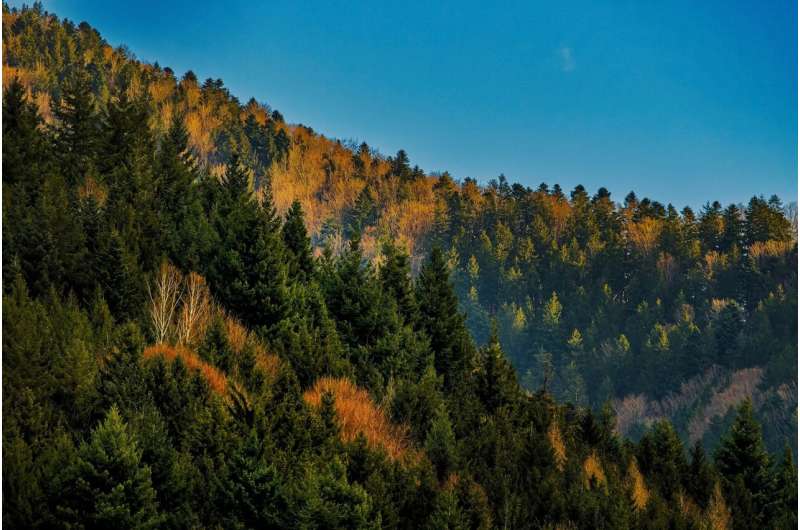Geologists find that low-relief mountain ranges are the largest carbon sinks

For many hundreds of millions of years, the average temperature at the surface of the Earth has varied by not much more than 20° Celsius, facilitating life on our planet. To maintain such stable temperatures, Earth must have a 'thermostat' that regulates the concentration of atmospheric carbon dioxide over geological timescales, influencing global temperatures.
The erosion and weathering of rocks are important parts of this 'thermostat.' A team led by LMU geologist Aaron Bufe and Niels Hovius from the German Research Center for Geosciences has now modeled the influence of these processes on carbon in the atmosphere. Their surprising result: CO2 capture through weathering reactions is highest in low-relief mountain ranges with moderate erosion rates and not where erosion rates are fastest.
Weathering occurs when rock is exposed to water and wind. "When silicates weather, carbon is removed from the atmosphere and later precipitated as calcium carbonate. By contrast, weathering of other phases—such as carbonates and sulfides or organic carbon contained in rocks—releases CO2. These reactions are typically much faster than silicate weathering," says Hovius.
"As a consequence, the impact of mountain building on the carbon cycle is complex."
Weathering model shows common mechanisms
To address this complexity, the researchers used a weathering model to analyze fluxes of sulfide, carbonate, and silicate weathering in a number of targeted study regions—such as Taiwan and New Zealand—with large ranges in erosion rates. They published their findings in Science.
"We discovered similar behaviors in all locations, pointing to common mechanisms," says Bufe.
Further modeling showed that the relationship between erosion and CO2-fluxes is not linear, but that CO2 capture from weathering peaks at an erosion rate of approximately 0.1 millimeters per year. When rates are lower or higher, less CO2 is sequestered and CO2 may even be released into the atmosphere.
"High erosion rates like in Taiwan or the Himalayas push weathering into being a CO2 source, because silicate weathering stops increasing with erosion rates at some point, whereas the weathering of carbonates and sulfides increases further," explains Bufe.
In landscapes with moderate erosion rates of around 0.1 millimeters per year, the rapidly weathering carbonates and sulfides are largely depleted, whereas silicate minerals are abundant and weather efficiently.
Where erosion is even slower than 0.1 millimeters per year, only few minerals are left to weather. The biggest CO2 sinks are therefore low-relief mountain ranges such as the Black Forest or the Oregon Coast Range, where erosion rates approach the optimum.
"Over geological timescales, the temperature to which Earth's 'thermostat' is set therefore depends strongly on the global distribution of erosion rates," says Bufe.
To understand the effects of erosion on Earth's climate system in greater detail, Bufe thinks that future studies should additionally consider organic carbon sinks and weathering in floodplains.
More information: Aaron Bufe, CO2 drawdown from weathering maximized at moderate erosion rates, Science (2024). DOI: 10.1126/science.adk0957. www.science.org/doi/10.1126/science.adk0957
Journal information: Science
Provided by Ludwig Maximilian University of Munich Mountain growth influences greenhouse effect
No comments:
Post a Comment